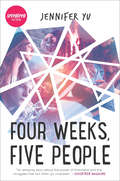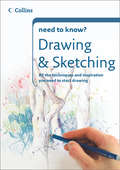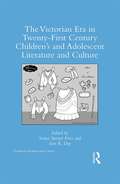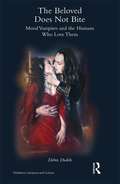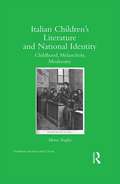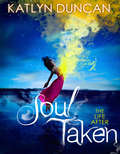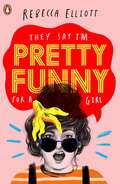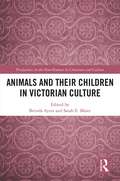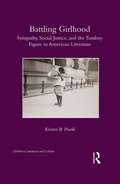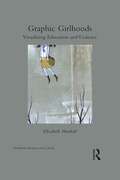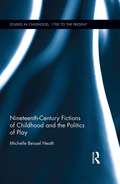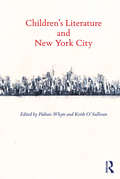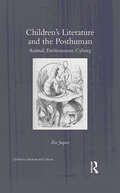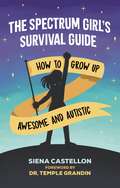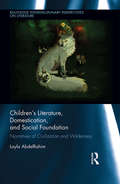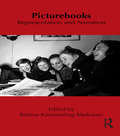- Table View
- List View
Drawing and Sketching (Collins Need to Know?)
by CollinsThis practical one-stop guide will show you all the techniques and inspiration you need to start drawing. To make your progress easier, it comes in a handy ebook format with colour illustrations and expert advice throughout.
The Victorian Era in Twenty-First Century Children’s and Adolescent Literature and Culture
by Sara K. Day Sonya Sawyer FritzVictorian literature for audiences of all ages provides a broad foundation upon which to explore complex and evolving ideas about young people. In turn, this collection argues, contemporary works for young people that draw on Victorian literature and culture ultimately reflect our own disruptions and upheavals, particularly as they relate to child and adolescent readers and our experiences of them. The essays therein suggest that we struggle now, as the Victorians did then, to assert a cohesive understanding of young readers, and that this lack of cohesion is a result of or a parallel to the disruptions taking place on a larger (even global) scale.
The Victorian Era in Twenty-First Century Children’s and Adolescent Literature and Culture (Children's Literature And Culture Ser.)
by Sonya Sawyer Fritz Sara K. DayVictorian literature for audiences of all ages provides a broad foundation upon which to explore complex and evolving ideas about young people. In turn, this collection argues, contemporary works for young people that draw on Victorian literature and culture ultimately reflect our own disruptions and upheavals, particularly as they relate to child and adolescent readers and our experiences of them. The essays therein suggest that we struggle now, as the Victorians did then, to assert a cohesive understanding of young readers, and that this lack of cohesion is a result of or a parallel to the disruptions taking place on a larger (even global) scale.
The Beloved Does Not Bite: Moral Vampires and the Humans Who Love Them (Children's Literature and Culture)
by Debra DudekIn this new monograph, author Debra Dudek defines a new era of vampire texts in which vampires have moved from their iconic dark, feared, often seductive figure lingering in alleys, to the beloved and morally sensitive vampire winning the affections of teen protagonists throughout pop culture. Dudek takes a close look at three hugely-popular vampire series for young adults, drawing parallels between the TV series Buffy the Vampire Slayer, the Twilight Saga novels/films, and The Vampire Diaries TV series/book series. By defining a new era of vampire texts and situating these three series within this transition, The Beloved Does Not Bite signals their significance and lays the groundwork for future scholarship on the flourishing genre of paranormal romances for young adults.
Italian Children’s Literature and National Identity: Childhood, Melancholy, Modernity (Children's Literature and Culture)
by Maria TruglioThis book bridges the fields of Children’s Literature and Italian Studies by examining how turn-of-the-century children’s books forged a unified national identity for the new Italian State. Through contextualized close readings of a wide range of texts, Truglio shows how the 19th-century concept of recapitulation, which held that ontogeny (the individual’s development) repeats phylogeny (the evolution of the species), underlies the strategies of this corpus. Italian fairy tales, novels, poems, and short stories imply that the personal development of the child corresponds to and hence naturalizes the modernizing development of the nation. In the context of Italy’s uneven and ambivalent modernization, these narrative trajectories are enabled by a developmental melancholia. Using a psychoanalytic lens, and in dialogue with recent Anglophone Children’s Literature criticism, this study proposes that national identity was constructed via a process of renouncing and incorporating paternal and maternal figures, rendered as compulsory steps into maturity and modernity. With chapters on the heroic figure of Garibaldi, the Orientalized depiction of the South, and the role of girls in formation narratives, this book discloses how melancholic itineraries produced gendered national subjects. This study engages both well-known Italian texts, such as Collodi’s The Adventures of Pinocchio and De Amicis’ Heart, and books that have fallen into obscurity by authors such as Baccini, Treves, Gianelli, and Nuccio. Its approach and corpus shed light on questions being examined by Italianists, Children’s Literature scholars, and social and cultural historians with an interest in national identity formation.
Italian Children’s Literature and National Identity: Childhood, Melancholy, Modernity (Children's Literature and Culture)
by Maria TruglioThis book bridges the fields of Children’s Literature and Italian Studies by examining how turn-of-the-century children’s books forged a unified national identity for the new Italian State. Through contextualized close readings of a wide range of texts, Truglio shows how the 19th-century concept of recapitulation, which held that ontogeny (the individual’s development) repeats phylogeny (the evolution of the species), underlies the strategies of this corpus. Italian fairy tales, novels, poems, and short stories imply that the personal development of the child corresponds to and hence naturalizes the modernizing development of the nation. In the context of Italy’s uneven and ambivalent modernization, these narrative trajectories are enabled by a developmental melancholia. Using a psychoanalytic lens, and in dialogue with recent Anglophone Children’s Literature criticism, this study proposes that national identity was constructed via a process of renouncing and incorporating paternal and maternal figures, rendered as compulsory steps into maturity and modernity. With chapters on the heroic figure of Garibaldi, the Orientalized depiction of the South, and the role of girls in formation narratives, this book discloses how melancholic itineraries produced gendered national subjects. This study engages both well-known Italian texts, such as Collodi’s The Adventures of Pinocchio and De Amicis’ Heart, and books that have fallen into obscurity by authors such as Baccini, Treves, Gianelli, and Nuccio. Its approach and corpus shed light on questions being examined by Italianists, Children’s Literature scholars, and social and cultural historians with an interest in national identity formation.
The Beloved Does Not Bite: Moral Vampires and the Humans Who Love Them (Children's Literature and Culture)
by Debra DudekIn this new monograph, author Debra Dudek defines a new era of vampire texts in which vampires have moved from their iconic dark, feared, often seductive figure lingering in alleys, to the beloved and morally sensitive vampire winning the affections of teen protagonists throughout pop culture. Dudek takes a close look at three hugely-popular vampire series for young adults, drawing parallels between the TV series Buffy the Vampire Slayer, the Twilight Saga novels/films, and The Vampire Diaries TV series/book series. By defining a new era of vampire texts and situating these three series within this transition, The Beloved Does Not Bite signals their significance and lays the groundwork for future scholarship on the flourishing genre of paranormal romances for young adults.
Soul Taken: Soul Taken / Soul Possessed / Soul Betrayed (The Life After trilogy #1)
by Katlyn DuncanAfter-life just got a lot more complicated
Pretty Funny
by Rebecca Elliott"This book is filled with loveable characters, witty dialogue and proper LOLS which made recording the audiobook hard - because I kept giggling!" Sharon RooneyDoes anyone ever really want to 'fall' in love? Knowing me I'll just trip over it and graze my knee on the gravel of humiliation.Haylah Swinton is fairly confident she's brilliant at being a girl. She's an ace best friend, a loving daughter, and an INCREDIBLY patient sister to her four-year-old total nutter of a brother, Noah. But she has a secret. She wants to be a stand-up comedian, but she's pretty sure girls like her - big girls, girls who don't get all the boys, girls who a lot of people don't see - don't belong on stage. That hasn't stopped her dreaming though, and when the seemingly perfect opportunity to write routines for older, cooler, impossibly funny Leo arises . . . well, what's a girl to do? But is Leo quite an interested in helping Haylah as he says he is? Will Haylah ever find the courage to step into the spotlight herself? And when oh when will people stop telling her she's 'funny for a girl'?!
Animals and Their Children in Victorian Culture (Perspectives on the Non-Human in Literature and Culture)
by Brenda Ayres Sarah Elizabeth MaierWhether a secularized morality, biblical worldview, or unstated set of mores, the Victorian period can and always will be distinguished from those before and after for its pervasive sense of the "proper way" of thinking, speaking, doing, and acting. Animals in literature taught Victorian children how to be behave. If you are a postmodern posthumanist, you might argue, "But the animals in literature did not write their own accounts." Animal characters may be the creations of writers’ imagination, but animals did and do exist in their own right, as did and do humans. The original essays in Animals and Their Children in Victorian explore the representation of animals in children’s literature by resisting an anthropomorphized perception of them. Instead of focusing on the domestication of animals, this book analyzes how animals in literature "civilize" children, teaching them how to get along with fellow creatures—both human and nonhuman.
Battling Girlhood: Sympathy, Social Justice, and the Tomboy Figure in American Literature
by Kristen B. ProehlFrom Jo March of Little Women (1868) to Katniss Everdeen of The Hunger Games (2008), the American tomboy figure has evolved into an icon of modern girlhood and symbol of female empowerment. Battling Girlhood: Sympathy, Social Justice, and the Tomboy Figure in American Literature traces the development of the tomboy figure from its origins in nineteenth-century sentimental novels to twentieth- and twenty-first-century literature and film.
Battling Girlhood: Sympathy, Social Justice, and the Tomboy Figure in American Literature
by Kristen B. ProehlFrom Jo March of Little Women (1868) to Katniss Everdeen of The Hunger Games (2008), the American tomboy figure has evolved into an icon of modern girlhood and symbol of female empowerment. Battling Girlhood: Sympathy, Social Justice, and the Tomboy Figure in American Literature traces the development of the tomboy figure from its origins in nineteenth-century sentimental novels to twentieth- and twenty-first-century literature and film.
Animals and Their Children in Victorian Culture (Perspectives on the Non-Human in Literature and Culture)
by Brenda Ayres Sarah Elizabeth MaierWhether a secularized morality, biblical worldview, or unstated set of mores, the Victorian period can and always will be distinguished from those before and after for its pervasive sense of the "proper way" of thinking, speaking, doing, and acting. Animals in literature taught Victorian children how to be behave. If you are a postmodern posthumanist, you might argue, "But the animals in literature did not write their own accounts." Animal characters may be the creations of writers’ imagination, but animals did and do exist in their own right, as did and do humans. The original essays in Animals and Their Children in Victorian explore the representation of animals in children’s literature by resisting an anthropomorphized perception of them. Instead of focusing on the domestication of animals, this book analyzes how animals in literature "civilize" children, teaching them how to get along with fellow creatures—both human and nonhuman.
Graphic Girlhoods: Visualizing Education and Violence
by Elizabeth MarshallDrawing on a dynamic set of "graphic texts of girlhood," Elizabeth Marshall identifies the locations, cultural practices, and representational strategies through which schoolgirls experience real and metaphorical violence. How is the schoolgirl made legible through violence in graphic texts of girlhood? What knowledge about girlhood and violence are under erasure within mainstream images and scripts about the schoolgirl? In what ways has the schoolgirl been pictured in graphic narratives to communicate feminist knowledge, represent trauma, and/or testify about social violence? Graphic Girlhoods focuses on these questions to make visible and ultimately question how sexism, racism and other forms of structural violence inform education and girlhood. From picture books about mean girls The Recess Queen or graphic novels like Jane, The Fox and Me to Ronald Searle's ghastly pupils in the St. Trinian's cartoons to graphic memoirs about schooling by adult women, such as Ruby Bridges's Through My Eyes and Lynda Barry's One Hundred Demons texts for and about the schoolgirl stake a claim in ongoing debates about gender and education.
Graphic Girlhoods: Visualizing Education and Violence (Children's Literature And Culture Ser.)
by Elizabeth MarshallDrawing on a dynamic set of "graphic texts of girlhood," Elizabeth Marshall identifies the locations, cultural practices, and representational strategies through which schoolgirls experience real and metaphorical violence. How is the schoolgirl made legible through violence in graphic texts of girlhood? What knowledge about girlhood and violence are under erasure within mainstream images and scripts about the schoolgirl? In what ways has the schoolgirl been pictured in graphic narratives to communicate feminist knowledge, represent trauma, and/or testify about social violence? Graphic Girlhoods focuses on these questions to make visible and ultimately question how sexism, racism and other forms of structural violence inform education and girlhood. From picture books about mean girls The Recess Queen or graphic novels like Jane, The Fox and Me to Ronald Searle's ghastly pupils in the St. Trinian's cartoons to graphic memoirs about schooling by adult women, such as Ruby Bridges's Through My Eyes and Lynda Barry's One Hundred Demons texts for and about the schoolgirl stake a claim in ongoing debates about gender and education.
Nineteenth-Century Fictions of Childhood and the Politics of Play (Studies in Childhood, 1700 to the Present)
by Michelle Beissel HeathDrawing evidence from transatlantic literary texts of childhood as well as from nineteenth and early twentieth century children’s and family card, board, and parlor games and games manuals, Nineteenth-Century Fictions of Childhood and the Politics of Play aims to reveal what might be thought of as "playful literary citizenship," or some of the motivations inherent in later nineteenth and early twentieth century Anglo-American play pursuits as they relate to interest in shaping citizens through investment in "good" literature. Tracing play, as a societal and historical construct, as it surfaces time and again in children’s literary texts as well as children’s literary texts as they surface time and again in situations and environments of children’s play, this book underscores how play and literature are consistently deployed in tandem in attempts to create ideal citizens – even as those ideals varied greatly and were dependent on factors such as gender, ethnicity, colonial status, and class.
Nineteenth-Century Fictions of Childhood and the Politics of Play (Studies in Childhood, 1700 to the Present)
by Michelle Beissel HeathDrawing evidence from transatlantic literary texts of childhood as well as from nineteenth and early twentieth century children’s and family card, board, and parlor games and games manuals, Nineteenth-Century Fictions of Childhood and the Politics of Play aims to reveal what might be thought of as "playful literary citizenship," or some of the motivations inherent in later nineteenth and early twentieth century Anglo-American play pursuits as they relate to interest in shaping citizens through investment in "good" literature. Tracing play, as a societal and historical construct, as it surfaces time and again in children’s literary texts as well as children’s literary texts as they surface time and again in situations and environments of children’s play, this book underscores how play and literature are consistently deployed in tandem in attempts to create ideal citizens – even as those ideals varied greatly and were dependent on factors such as gender, ethnicity, colonial status, and class.
Children's Literature and New York City (Children's Literature and Culture)
by Padraic Whyte Keith O'SullivanThis collection explores the significance of New York City in children’s literature, stressing literary, political, and societal influences on writing for young people from the twentieth century to the present day. Contextualized in light of contemporary critical and cultural theory, the chapters examine the varying ways in which children’s literature has engaged with New York City as a city space, both in terms of (urban) realism and as an ‘idea’, such as the fantasy of the city as a place of opportunity, or other associations. The collection visits not only dominant themes, motifs, and tropes, but also the different narrative methods employed to tell readers about the history, function, physical structure, and conceptualization of New York City, acknowledging the shared or symbiotic relationship between literature and the city: just as literature can give imaginative ‘reality’ to the city, the city has the potential to shape the literary text. This book critically engages with most of the major forms and genres for children/young adults that dialogue with New York City, and considers such authors as Margaret Wise Brown, Felice Holman, E. L. Konigsburg, Maurice Sendak, J. D. Salinger, John Donovan, Shaun Tan, Elizabeth Enright, and Patti Smith.
Children's Literature and New York City (Children's Literature and Culture)
by Pádraic Whyte Keith O’SullivanThis collection explores the significance of New York City in children’s literature, stressing literary, political, and societal influences on writing for young people from the twentieth century to the present day. Contextualized in light of contemporary critical and cultural theory, the chapters examine the varying ways in which children’s literature has engaged with New York City as a city space, both in terms of (urban) realism and as an ‘idea’, such as the fantasy of the city as a place of opportunity, or other associations. The collection visits not only dominant themes, motifs, and tropes, but also the different narrative methods employed to tell readers about the history, function, physical structure, and conceptualization of New York City, acknowledging the shared or symbiotic relationship between literature and the city: just as literature can give imaginative ‘reality’ to the city, the city has the potential to shape the literary text. This book critically engages with most of the major forms and genres for children/young adults that dialogue with New York City, and considers such authors as Margaret Wise Brown, Felice Holman, E. L. Konigsburg, Maurice Sendak, J. D. Salinger, John Donovan, Shaun Tan, Elizabeth Enright, and Patti Smith.
Children's Literature and the Posthuman: Animal, Environment, Cyborg (Children's Literature and Culture)
by Zoe JaquesAn investigation of identity formation in children's literature, this book brings together children’s literature and recent critical concerns with posthuman identity to argue that children’s fiction offers sophisticated interventions into debates about what it means to be human, and in particular about humanity’s relationship to animals and the natural world. In complicating questions of human identity, ecology, gender, and technology, Jaques engages with a multifaceted posthumanism to understand how philosophy can emerge from children's fantasy, disclosing how such fantasy can build upon earlier traditions to represent complex issues of humanness to younger audiences. Interrogating the place of the human through the non-human (whether animal or mechanical) leads this book to have interpretations that radically depart from the critical tradition, which, in its concerns with the socialization and representation of the child, has ignored larger epistemologies of humanness. The book considers canonical texts of children's literature alongside recent bestsellers and films, locating texts such as Gulliver’s Travels (1726), Pinocchio (1883) and the Alice books (1865, 1871) as important works in the evolution of posthuman ideas. This study provides radical new readings of children’s literature and demonstrates that the genre offers sophisticated interventions into the nature, boundaries and dominion of humanity.
The Spectrum Girl's Survival Guide: How to Grow Up Awesome and Autistic
by Siena Castellon"Never be ashamed of being different: it is this difference that makes you extraordinary and unique." This essential go-to guide gives you all the advice and tools you'll need to help you flourish and achieve what you want in life. From the answers to everyday questions such as 'Am I using appropriate body language?' and 'Did I say the wrong thing?', through to discussing the importance of understanding your emotions, looking after your physical and mental health and coping with anxiety and sensory overloads, award-winning neurodiversity campaigner Siena Castellon uses her own experiences to provide you with the skills to overcome any challenge. With practical tips on friendships, dating, body image, consent and appearance, as well as how to survive school and bullying, The Spectrum Girl's Survival Guide gives you the power to embrace who you are, reminding you that even during the toughest of teen moments, you are never alone.
Children's Literature, Domestication, and Social Foundation: Narratives of Civilization and Wilderness (Routledge Interdisciplinary Perspectives on Literature)
by Layla AbdelRahimThis study of children's literature as knowledge, culture, and social foundation bridges the gap between science and literature and examines the interconnectedness of fiction and reality as a two-way road. The book investigates how the civilized narrative orders experience by means of segregation, domestication, breeding, and extermination, arguing instead that the stories and narratives of wilderness project chaos and infinite possibilities for experiencing the world through a diverse community of life. AbdelRahim engages these narratives in a dialogue with each other and traces their expression in the various disciplines and books written for both children and adults, analyzing the manifestation of fictional narratives in real life. This is both an inter- and multi-disciplinary endeavor that is reflected in the combination of research methods drawn from anthropology and literary studies as well as in the tracing of the narratives of order and chaos, or civilization and wilderness, in children's literature and our world. Chapters compare and contrast fictional children's books that offer different real-world socio-economic paradigms, such as A.A. Milne's Winnie-the-Pooh projecting a civilized monarcho-capitalist world, Nikolai Nosov's trilogy on The Adventures of Dunno and Friends presenting the challenges and feats of an anarcho-socialist society in evolution from primitivism towards technology, and Tove Jansson's Moominbooks depicting the harmony of anarchy, chaos, and wildness. AbdelRahim examines the construction, transmission, and acquisition of knowledge in children’s literature by visiting the very nature of literature, culture, and language and the civilized structures that domesticate the world. She brings radically new perspectives to the knowledge, culture, and construction of human beings, making an invaluable contribution to a wide range of disciplines and for those engaged in revolutionizing contemporary debates on the nature of knowledge, human identity, and the world.
Children's Literature, Domestication, and Social Foundation: Narratives of Civilization and Wilderness (Routledge Interdisciplinary Perspectives on Literature)
by Layla AbdelRahimThis study of children's literature as knowledge, culture, and social foundation bridges the gap between science and literature and examines the interconnectedness of fiction and reality as a two-way road. The book investigates how the civilized narrative orders experience by means of segregation, domestication, breeding, and extermination, arguing instead that the stories and narratives of wilderness project chaos and infinite possibilities for experiencing the world through a diverse community of life. AbdelRahim engages these narratives in a dialogue with each other and traces their expression in the various disciplines and books written for both children and adults, analyzing the manifestation of fictional narratives in real life. This is both an inter- and multi-disciplinary endeavor that is reflected in the combination of research methods drawn from anthropology and literary studies as well as in the tracing of the narratives of order and chaos, or civilization and wilderness, in children's literature and our world. Chapters compare and contrast fictional children's books that offer different real-world socio-economic paradigms, such as A.A. Milne's Winnie-the-Pooh projecting a civilized monarcho-capitalist world, Nikolai Nosov's trilogy on The Adventures of Dunno and Friends presenting the challenges and feats of an anarcho-socialist society in evolution from primitivism towards technology, and Tove Jansson's Moominbooks depicting the harmony of anarchy, chaos, and wildness. AbdelRahim examines the construction, transmission, and acquisition of knowledge in children’s literature by visiting the very nature of literature, culture, and language and the civilized structures that domesticate the world. She brings radically new perspectives to the knowledge, culture, and construction of human beings, making an invaluable contribution to a wide range of disciplines and for those engaged in revolutionizing contemporary debates on the nature of knowledge, human identity, and the world.
Picturebooks: Representation and Narration (Children's Literature and Culture)
by Bettina Kümmerling-MeibauerThis volume discusses the aesthetic and cognitive challenges of modern picturebooks from different countries, such as Denmark, France, Germany, Norway, Spain, Sweden, United Kingdom, and USA. The overarching issue concerns the mutual relationship between representation and narration by means of the picturebooks’ multimodal character. Moreover, this volume includes the main lines of debate and approaches to picturebooks by international leading researchers in the field. Topics covered are the impact of paratexts and interpictorial allusions, the relationship between artists’ books, crossover picturebooks, and picturebooks for adults, the narrative defiance of wordless picturebooks, the representation of emotions in images and text, and the depiction of hybrid characters in picturebooks. The enlargement of the picturebook corpus beyond an Anglo-American picturebook canon opens up new horizons and highlights the diverging styles and genre shifts in modern picturebooks. This tendency also demonstrates the influence of specific authors and illustrators on the appreciation of the picturebook genre, as in the case of Astrid Lindgren’s picturebooks and the picturebooks created by renowned illustrators, such as Anthony Browne, Wolf Erlbruch, Stian Hole, and Bruno Munari. This book will be the definite contribution to contemporary picturebook research for many years to come.
